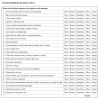Andy
Senior Member (Voting rights)
Abstract
Central Sensitization (CS) has been proposed as a common pathophysiological mechanism to explain related syndromes for which no specific organic cause can be found. The term Central Sensitivity Syndrome (CSS) has been proposed to describe these poorly understood disorders related to CS.
The goal of this investigation was to develop the Central Sensitization Inventory (CSI), which identifies key symptoms associated with CSSs, and quantifies the degree of these symptoms. The utility of the CSI, to differentiate among different types of chronic pain patients that presumably have different levels of CS impairment, was then evaluated.
Study 1 demonstrated strong psychometric properties (test-retest reliability = 0.817; Cronbach's alpha = 0.879) of the CSI in a cohort of normative subjects. A factor analysis (including both normative and chronic pain subjects) yielded 4 major factors (all related to somatic and emotional symptoms), accounting for 53.4% of the variance in the dataset.
In Study 2, the CSI was administered to four groups: fibromyalgia (FM); chronic widespread pain (CWP) without FM; work-related regional chronic low back pain (CLBP); and normative control group. Analyses revealed that the FM patients reported the highest CSI scores, and the normative population the lowest (p<.05). Analyses also demonstrated that the prevalence of previously diagnosed CSSs and related disorders was highest in the FM group and lowest in the normative group (p<.001).
Taken together, these two studies demonstrate the psychometric strength, clinical utility, and the initial construct validity of the CSI in evaluating CS-related clinical symptoms in chronic pain populations.
Paragraph breaks added for easier reading.
Open access, https://www.ncbi.nlm.nih.gov/pmc/articles/PMC3248986/
Central Sensitization (CS) has been proposed as a common pathophysiological mechanism to explain related syndromes for which no specific organic cause can be found. The term Central Sensitivity Syndrome (CSS) has been proposed to describe these poorly understood disorders related to CS.
The goal of this investigation was to develop the Central Sensitization Inventory (CSI), which identifies key symptoms associated with CSSs, and quantifies the degree of these symptoms. The utility of the CSI, to differentiate among different types of chronic pain patients that presumably have different levels of CS impairment, was then evaluated.
Study 1 demonstrated strong psychometric properties (test-retest reliability = 0.817; Cronbach's alpha = 0.879) of the CSI in a cohort of normative subjects. A factor analysis (including both normative and chronic pain subjects) yielded 4 major factors (all related to somatic and emotional symptoms), accounting for 53.4% of the variance in the dataset.
In Study 2, the CSI was administered to four groups: fibromyalgia (FM); chronic widespread pain (CWP) without FM; work-related regional chronic low back pain (CLBP); and normative control group. Analyses revealed that the FM patients reported the highest CSI scores, and the normative population the lowest (p<.05). Analyses also demonstrated that the prevalence of previously diagnosed CSSs and related disorders was highest in the FM group and lowest in the normative group (p<.001).
Taken together, these two studies demonstrate the psychometric strength, clinical utility, and the initial construct validity of the CSI in evaluating CS-related clinical symptoms in chronic pain populations.
Paragraph breaks added for easier reading.
Open access, https://www.ncbi.nlm.nih.gov/pmc/articles/PMC3248986/
Last edited by a moderator:


